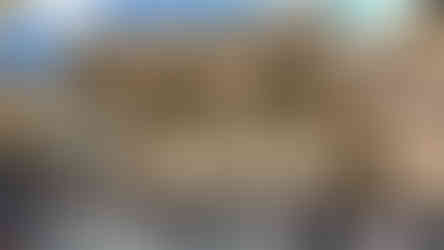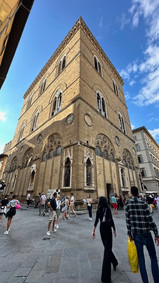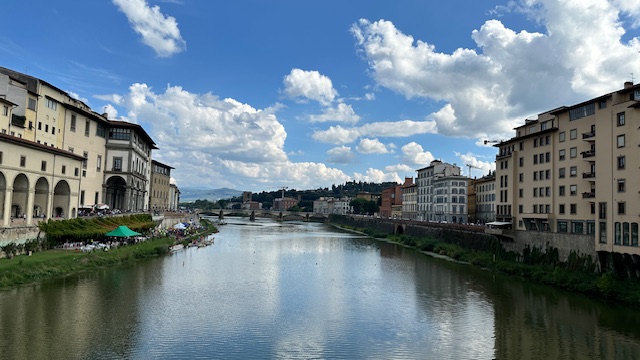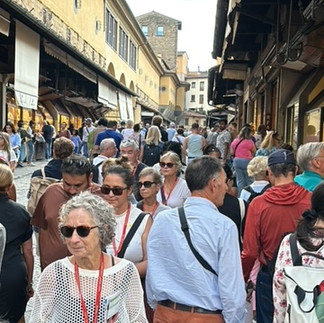Florence Sights - Attrazioni di Firenze
- Maria Scuor
- Dec 11, 2024
- 14 min read
Italiano sotto ogni sezione
Here is a TikTok video of some of Florence’s Sights - Ecco un video TikTok di alcune delle attrazioni di Firenze
We spent a couple of days with Tashya and Nicolas in Florence and saw some amazing sights. I couldn’t believe how many tourists were still in Florence in October. It was hard to walk around without bumping into someone. I had to get up really early to get good photos.
Abbiamo trascorso un paio di giorni con Tashya e Nicolas a Firenze e abbiamo visto alcuni luoghi incredibili. Non riuscivo a credere a quanti turisti ci fossero ancora a Firenze nel mese di ottobre. Era difficile andare in giro senza imbattersi in qualcuno. Ho dovuto alzarmi molto presto per fare buone foto.
Piazza della Repubblica
Piazza della Repubblica is the square in Florence which originally was the site of the forum or market place. The Colonna della Dovizia or the Column of Abundance marks the point where the cardus and decumanus maximi met and where the Roman forum stood. The present column dates to 1431 but the statue on top is a copy and the original is visible at the bank Cassa di Risparmio in via dell'Oriuolo.
In the 16th century, the construction of the Mercato Nuovo near Ponte Vecchio led to renaming the market here Mercato Vecchio. During medieval times, the area around the column was very populated with markets, tabernacles and churches. In the mid-18th century, the last duke of Florence, Cosimo I, imposed a Jewish Ghetto on the site. He collected the Jews of the city and placed them in this area. The only thing remaining of this era is the column.
The piazza in its current form was due to the destruction and clean up of the medieval structures when Florence was the capital of Italy in 1865 – 1871. The 13th century walls were also removed to make room for the wide boulevard. The piazza today transforms to a stage for street artists and shows after sunset and tourist can have coffee at the historical Caffé Gilli, Caffé Paskowski and Caffé delle Giubbe Rosse which were meeting points for many of the city's artists and writers in the past.
Photos of Piazza della Repubblica - Ecco foto di Piazza della Repubblica
Piazza della Repubblica
Piazza della Repubblica è la piazza di Firenze che in origine era il luogo del foro o del mercato. La Colonna della Dovizia o Colonna dell'Abbondanza segna il punto in cui il cardo e il decumano maximi si incontravano e dove sorgeva il foro romano. L'attuale colonna risale al 1431 ma la statua in alto è una copia e l'originale è visibile presso la Cassa di Risparmio in via dell'Oriuolo.
Nel XVI secolo, la costruzione del Mercato Nuovo nei pressi di Ponte Vecchio portò a rinominare il mercato qui Mercato Vecchio. Durante il Medioevo, l'area intorno alla colonna era molto popolata da mercati, tabernacoli e chiese. A metà del XVIII secolo, l'ultimo duca di Firenze, Cosimo I, impose un ghetto ebraico sul sito. Radunò gli ebrei della città e li collocò in questa zona. L'unica cosa rimasta di quest'epoca è la colonna.
La piazza nella sua forma attuale è dovuta alla distruzione e alla pulizia delle strutture medievali quando Firenze era capitale d'Italia nel 1865 – 1871. Anche le mura del XIII secolo furono rimosse per fare spazio all'ampio viale. La piazza oggi si trasforma in palcoscenico per artisti di strada e spettacoli dopo il tramonto e i turisti possono prendere un caffè presso gli storici Caffè Gilli, Caffè Paskowski e Caffè delle Giubbe Rosse che in passato sono stati punti di ritrovo di molti artisti e scrittori della città.
Palazzo Strozzi
The prominent Florentine Filippo Strozzi had an ambitious vision of building the largest and grandest palaces in Florence. Taking 16 years between 1473 – 1489 It became a testament to the Strozzi family's aspiration for greatness and their contribution to the cultural and political landscape of Florence. In the 14th century towers were added and in the 16th century the east wing was added to give the building a unique blend of medieval and Renaissance architecture. It is said that 15 buildings had to be demolished to build this grandiose palace.
This was the Strozzi’s family residence during the 16th century however, the family faced challenging and political unrest, leading them to live in Rome. Therefore, the palace went through period of neglect. The palace remained in the Strozzi family until 28 May 1937, when Prince Roberto sold it too the Istituto Nazionale delle Assicurazioni (INA). The INA made extensive renovations between 1938 – 1940 and transformed the palace into a vibrant cultural venue, preserving its historical legacy while opening it up to the world.
Strozzi Palace is now a renowned cultural center that hosts world-class art exhibitions, concerts, and events. With its stunning Renaissance architecture, fascinating history, and vibrant cultural scene, Strozzi Palace is a must-visit destination for anyone traveling to Florence.
We didn’t go inside Palazzo Strozzi but here are photos of the exterior - Non siamo entrati all'interno di Palazzo Strozzi ma ecco foto dell'esterno
Palazzo Strozzi
L'eminente fiorentino Filippo Strozzi aveva l'ambiziosa visione di costruire i palazzi più grandi e grandiosi di Firenze. Durato 16 anni, tra il 1473 e il 1489, divenne una testimonianza dell'aspirazione alla grandezza della famiglia Strozzi e del loro contributo al panorama culturale e politico di Firenze. Nel XIV secolo furono aggiunte le torri e nel XVI secolo fu aggiunta l'ala est per dare all'edificio una miscela unica di architettura medievale e rinascimentale. Si dice che 15 edifici dovettero essere demoliti per costruire questo grandioso palazzo.
Questa fu la residenza della famiglia Strozzi durante il XVI secolo, ma la famiglia dovette affrontare disordini politici e impegnativi, che li portarono a vivere a Roma. Pertanto, il palazzo attraversò un periodo di abbandono. Il palazzo rimase alla famiglia Strozzi fino al 28 maggio 1937, quando il principe Roberto lo vendette anche all'Istituto Nazionale delle Assicurazioni (INA). L'INA fece ampi lavori di ristrutturazione tra il 1938 e il 1940 e trasformò il palazzo in un vivace luogo culturale, preservando la sua eredità storica e aprendolo al mondo.
Palazzo Strozzi è oggi un rinomato centro culturale che ospita mostre d'arte, concerti ed eventi di livello mondiale. Con la sua splendida architettura rinascimentale, la storia affascinante e la vivace scena culturale, Palazzo Strozzi è una destinazione imperdibile per chiunque viaggi a Firenze.
Palazzo Vecchio
Palazzo (palace) Vecchio is located in Piazza della Signoria and has had several names such as: it began as Palazzo dei Prior in 1299 when architect Arnolfo di Cambio who, was inspired by the existing Palazzo di Priori in Volterra, began building it on the ruins of Palazzo dei Fanti. It changed names to Palazzo della Signoria in the 15th century when the palazzo became a seat of the Signoria, city council. In 1540 it became Palazzo Ducale, when Duke Cosimo I de’Medici made the palazzo his residence and finally in 1589 it became Palazzo Vecchio when the duke moved to Palazzo Pitti as his royal residence.
During the time the duke lived in the palazzo, it doubled in size to accommodate the needs of the ducal court. In 1565 the Vasari Corridor was built to connect Palazzo Vecchio to Palazzo Pitti crossing the Arno River on Ponte Vecchio. The palazzo was very important in 1865-1871, when it became the capital of the Kingdom of Italy and was the seat of the Chamber of Deputies.
Today the Palazzo is used as a museum and has remained the Town Hall of the Municipality of Florence which houses the mayor and city council offices. The beautiful clock tower known as Arnolfo’s Tower, was built in 1310 and stands 94 metres tall. It has three bells: The Martinella, used to call Florentines to assembly, The Midday bell, and The Chiming bell which is the largest.
Inside the palazzo, its function was to become the residence and workplace of the officials of the republic, so it has several rooms, each with a unique personality. The most important is the Hall of Five Hundred (Salone dei Cinquecento) which is the largest and most prestigious halls in Italy. It was meant to hold up to 500 citizens at the time of the Great Council and during the time Florence was the capital of the Kingdom of Italy, parliament met here. It truly is a symbol of civic power that has existed for more than seven centuries in Florence.
When visiting Piazza del Signoria, you will also see: Loggia di Lanzi, the Uffizi Gallery, Palazzo Uguccioni, Palazzo delle Assicurazioni Generali, Tribunale della Mercanzia, the Fountain of Neptune known by the Florentines as "il biancone" and many statues including the equestrian statue of Cosimo I, a work done in 1594 by Giambologna. There is also a copy of Michelangelo's David next to Palazzo Vecchio. The original is the Accademia Gallery of Florence and a third copy is in the middle of Piazzale Michelangelo.
Photos of Palazzo Vecchio and Piazza del Signoria - Foto di Palazzo Vecchio e Piazza della Signoria
Palazzo Vecchio
Palazzo Vecchio si trova in Piazza della Signoria e ha avuto diversi nomi come: nacque come Palazzo dei Priore nel 1299 quando l'architetto Arnolfo di Cambio che, ispirandosi al preesistente Palazzo dei Priori di Volterra, iniziò a costruirlo sulle rovine di Palazzo dei Fanti. Cambiò nome in Palazzo della Signoria nel XV secolo, quando il palazzo divenne sede del consiglio comunale della Signoria. Nel 1540 divenne Palazzo Ducale, quando il duca Cosimo I de' Medici ne fece la sua residenza e infine nel 1589 divenne Palazzo Vecchio quando il duca si trasferì a Palazzo Pitti come residenza reale.
Durante il periodo in cui il duca visse nel palazzo, raddoppiò le sue dimensioni per soddisfare le esigenze della corte ducale. Nel 1565 fu costruito il Corridoio Vasariano per collegare Palazzo Vecchio a Palazzo Pitti, attraversando il fiume Arno su Ponte Vecchio. Il palazzo ebbe un'importanza molto importante nel 1865-1871, quando divenne capitale del Regno d'Italia e fu sede della Camera dei Deputati.
Oggi il Palazzo è adibito a museo ed è rimasto il Palazzo Comunale del Comune di Firenze che ospita gli uffici del sindaco e del consiglio comunale. La bellissima torre dell'orologio, nota come Torre di Arnolfo, fu costruita nel 1310 e si erge per 94 metri di altezza. Ha tre campane: La Martinella, usata per chiamare i fiorentini all'assemblea, La campana di mezzogiorno, e La Campana del rintocco che è la più grande.
All'interno del palazzo, la sua funzione era quella di diventare la residenza e il luogo di lavoro dei funzionari della repubblica, quindi ha diverse stanze, ognuna con una personalità unica. Il più importante è il Salone dei Cinquecento che è il più grande e prestigioso d'Italia. Al momento del Maggior Consiglio era destinata a contenere fino a 500 cittadini e durante il periodo in cui Firenze era la capitale del Regno d'Italia, qui si riuniva il parlamento. È davvero un simbolo del potere civico che esiste da più di sette secoli a Firenze.
Visitando Piazza della Signoria, potrete anche vedere: la Loggia dei Lanzi, la Galleria degli Uffizi, Palazzo Uguccioni, il Palazzo delle Assicurazioni Generali, il Tribunale della Mercanzia, la Fontana del Nettuno conosciuta dai fiorentini come "il biancone" e molte statue tra cui la statua equestre di Cosimo I, opera realizzata nel 1594 dal Giambologna. C'è anche una copia di Il David di Michelangelo accanto a Palazzo Vecchio. L'originale è la Galleria dell'Accademia di Firenze e una terza copia si trova al centro di Piazzale Michelangelo.
Sights around Florence - Attrazioni nei dintorni di Firenze
Florence is absolutely beautiful and I was able to capture these photos of the sights around the town - Firenze è assolutamente bellissima e sono stato in grado di catturare queste foto delle attrazioni intorno alla città
Florence Bridges - Ponti di Firenze
Here is a TikTok video of the bridges we saw in Florence - Ecco un video TikTok dei ponti che abbiamo visto a Firenze
Ponte Vecchio
The Arno River is 241 km long and is the largest in the Tuscan region and passes through Florence. We walked over it across Ponte Vecchio and Ponte Santa Trinita. The river has flooded Florence several times but is used for drinking water, irrigation and firefighting.
The crossing of the Arno at Ponte Vecchio dates back to Roman times but Ponte Vecchio was built between 1335 and 1345, and has been rebuilt several times due to floods. For centuries Ponte Vecchio was the second oldest bridge after Ponte alle Grazie (also known as Ponte di Rubaconte) which was built in 1237. However, in 1944 Ponte alle Grazie bridge was destroyed by the retreating Germans during World War II, making Ponte Vecchio the oldest in Florence since then.
Photos of Ponte alla Grazie - Foto del Ponte alle Grazie
By 1442, the arches under the galleries were filled with small buildings and the city administration allowed the area to be used as greengrocers and butcher shops, which gave possibility to dispersing waste in the river. In 1495, the city sold the 48 shops to private individuals and religious bodies who enlarged them with projections on the river side. In 1565, architect Giorgio Vasari built the corridor connecting Palazzo Vecchio and Palazzo Pitti. By 1594, Duke Ferdinand I, decreed that the shops be occupied by goldsmiths and jewellery shops to avoid an ignoble trade and unpleasant odours under the windows of the suspended corridor.
In 1938, Mussolini had large windows built into the centre of the bridge for Hitler’s official visit on May 9th to strengthen relations between Italy and Germany. Interesting enough, Ponte Vecchio was the only bridge not blown up when the Germans retreated. Over the years, the bridge was damaged due to floods and has undergone significant transformations but the bridge has maintained its medieval and picturesque image.
The bridge is composed of three large low-arched crossings, it is an inhabited bridge with rows of artisan shops on both sides of the bridge, that started as porticoes and now are closed in. At the centre of the bridge the shops stop and it opens up to two views of the river which are spectacular.
The amount of people on the bridge was unbelievable. The 48 jewelry shops sell high end rings, necklaces, earrings, pendants, home décor, ornaments and so much more. All beautiful in their own right.
Photos of Ponte Vecchio - Foto di Ponte Vecchio
Photos of shopping on Ponte Vecchio - Foto dello shopping sul Ponte Vecchio
Ponte Vecchio
Il fiume Arno è lungo 241 km ed è il più grande della regione toscana e passa per Firenze. L'abbiamo attraversato a piedi attraverso Ponte Vecchio e Ponte Santa Trinità. Il fiume ha inondato Firenze più volte ma viene utilizzato per l'acqua potabile, l'irrigazione e la lotta antincendio.
L'attraversamento dell'Arno a Ponte Vecchio risale all'epoca romana ma Ponte Vecchio fu costruito tra il 1335 e il 1345, ed è stato ricostruito più volte a causa delle alluvioni. Per secoli Ponte Vecchio è stato il secondo ponte più antico dopo il Ponte alle Grazie (noto anche come Ponte di Rubaconte) che fu costruito nel 1237. Tuttavia, nel 1944 il Ponte alle Grazie fu distrutto dai tedeschi in ritirata durante la seconda guerra mondiale, rendendo Ponte Vecchio il più antico di Firenze da allora.
Entro il 1442 gli archi sotto le gallerie furono riempiti con piccoli edifici e l'amministrazione comunale permise che l'area fosse adibita a fruttivendoli e macellerie, il che dava la possibilità di disperdere i rifiuti nel fiume. Nel 1495 la città vendette le 48 botteghe a privati ed enti religiosi che le ampliarono con sporgenze sul lato del fiume. Nel 1565 l'architetto Giorgio Vasari costruì il corridoio che collegava Palazzo Vecchio a Palazzo Pitti. Nel 1594 il duca Ferdinando I, decretò che le botteghe fossero occupate da oreficerie e gioiellerie per evitare un commercio ignobile e odori sgradevoli sotto le finestre del corridoio sospeso.
Nel 1938 Mussolini fece costruire delle grandi vetrate al centro del ponte per la visita ufficiale di Hitler del 9 maggio per rafforzare le relazioni tra Italia e Germania. È interessante notare che Ponte Vecchio fu l'unico ponte a non bombardato quando i tedeschi si ritirarono. Nel corso degli anni, il ponte è stato danneggiato a causa delle inondazioni e ha subito notevoli trasformazioni ma il ponte ha mantenuto la sua immagine medievale e pittoresca.
Il ponte è composto da tre grandi attraversamenti ad arco ribassato, è un ponte abitato con file di botteghe artigiane su entrambi i lati del ponte, che partivano come portici e ora sono chiusi. Al centro del ponte si fermano i negozi e si apre su due viste sul fiume che sono spettacolari.
La quantità di persone sul ponte era incredibile. Le 48 gioiellerie vendono anelli, collane, orecchini, ciondoli, decorazioni per la casa, ornamenti e molto altro ancora. Tutti belli a sé stanti.
Ponte Santa Trinita
Ponte Santa Trinita crosses the Arno River and connects Florence’s historic centre and the Oltrarno district. The original wooden bridge was built in 1252 and destroyed by a flood of the river in 1269. It was rebuilt but again destroyed by the flood of 1333. Another bridge was built from 1356 to 1415 but that too collapsed due to the flood of 1557. After all these bridges collapsed another bridge that lasted centuries was built in 1570. Sadly, it was destroyed by bombs when the Germans retreated the area in 1944.
All the bridges destroyed by the Germans were rebuilt in modern era but the civil engineering department and other authoritative people choose to rebuild the Santa Trinita bridge “as it was and where it was”. The rebuilding started in 1955 with recovery of much of the stone material from the riverbed as well as most of the statues. On May 16, 1958 the new bridge was inaugurated however it was missing the head of the Statue of Spring. A 3,000-dollar reward was offered by antique dealer Luigi Bellini which was publicised all over the world, in newspapers and flyers.
The head was thought to have been stolen but in fact it had remained in the Arno and found a few meters downstream by a sand digger in 1961. Returning it to its place, 17 years after it’s detachments.
Photos of Ponte Santa Trinita - Foto di Ponte Santa Trinita
Ponte Santa Trinita
Ponte Santa Trinita attraversa il fiume Arno e collega il centro storico di Firenze e il quartiere dell'Oltrarno. Il ponte di legno originale fu costruito nel 1252 e distrutto da un'alluvione del fiume nel 1269. Fu ricostruita ma nuovamente distrutta dall'alluvione del 1333. Un altro ponte fu costruito tra il 1356 e il 1415 ma anche questo crollò a causa dell'alluvione del 1557. Dopo il crollo di tutti questi ponti, nel 1570 fu costruito un altro ponte che durò secoli. Purtroppo, fu distrutta dalle bombe quando i tedeschi si ritirarono nell'area nel 1944.
Tutti i ponti distrutti dai tedeschi sono stati ricostruiti in epoca moderna ma il genio civile e altre persone autorevoli scelgono di ricostruire il ponte Santa Trinita "com'era e dov'era". La ricostruzione iniziò nel 1955 con il recupero di gran parte del materiale lapideo dal letto del fiume e della maggior parte delle statue. Il 16 maggio 1958 fu inaugurato il nuovo ponte che però mancava della testa della Statua della Primavera. Un premio di 3.000 dollari fu offerto dall'antiquario Luigi Bellini che fu pubblicizzato in tutto il mondo, su giornali e volantini.
La testa si pensava fosse stata rubata ma in realtà era rimasta in Arno e ritrovata pochi metri a valle da uno scavatore di sabbia nel 1961. Riportandolo al suo posto, 17 anni dopo i suoi distacchi.
Shopping
We didn’t go to Florence to shop but I can say there is a lot of shopping to be had. The bridges video above ends with shopping on Ponte Vecchio which is always full of people walking the bridge and seeing the sights as well as purchasing a very sought after trinket.
There are several shopping districts in Florence but this day I captured Via Della Spada in the early morning so I could show you the stores without all the people. Here is where high-fashion stores have their flagship boutiques and the location is just off the downtown path. Boutiques such as Fendi, Gucci, Dior and many more are located in what used to be beautiful palazzi (palaces). For me It truly was a beautiful place to walk and window shop.
Here is a TikTok video and photos of Via Della Spada shopping - Ecco un video TikTok e le foto dello shopping di Via Della Spada
Shopping
Non siamo andati a Firenze per fare shopping, ma posso dire che c'è un sacco di shopping da fare. Il video dei ponti qui sopra termina con lo shopping su Ponte Vecchio, che è sempre pieno di persone che camminano sul ponte e vedono i luoghi d'interesse, oltre ad acquistare un gingillo molto ricercato.
Ci sono diversi quartieri dello shopping a Firenze ma questa giornata ho catturato Via Della Spada al mattino presto in modo da potervi mostrare i negozi senza tutta la gente. Qui è dove i negozi di alta moda hanno le loro boutique di punta e la posizione è appena fuori dal percorso del centro. Boutique come Fendi, Gucci, Dior e molte altre si trovano in quelli che un tempo erano bellissimi palazzi. Per me è stato davvero un bel posto per passeggiare e guardare le vetrine.


















































































































































































Comments